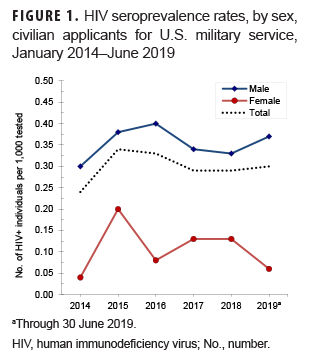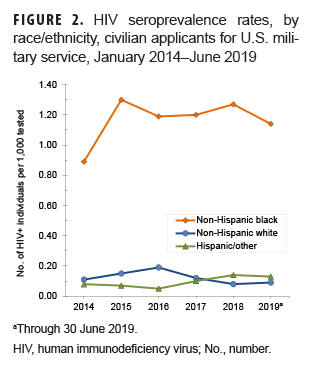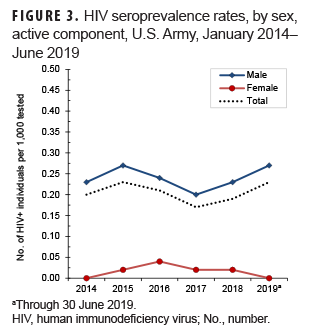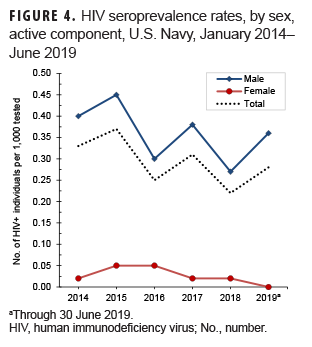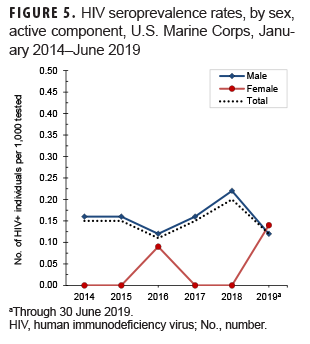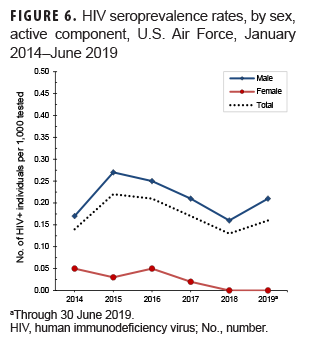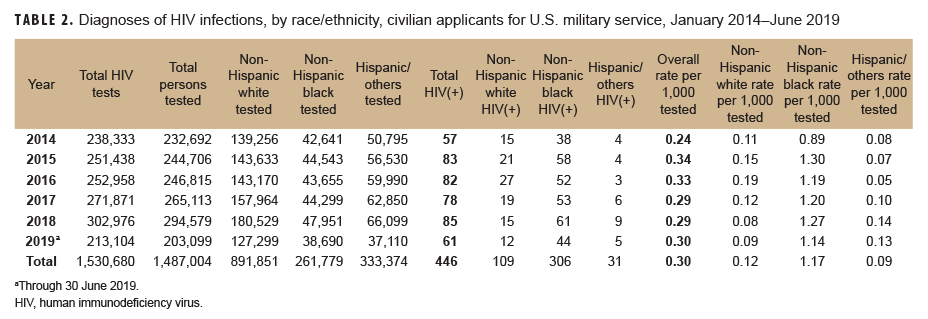Abstract
This report provides an update through June 2019 of the results of routine screening for antibodies to the human immunodeficiency virus (HIV) among civilian applicants for military service and among members of the active and reserve components of the U.S. Armed Forces. From Jan. 2014–June 2019, full-year seroprevalences among applicants for service peaked in 2015 (0.34 per 1,000 tested) and then decreased during the subsequent 2 years (0.33 and 0.29 per 1,000 tested, respectively). Seroprevalences also peaked in 2015 for active component service members of the Army, Navy, and Air Force and among reservists of the Navy and Marine Corps. Overall (Jan. 2014–June 2019) HIV antibody seroprevalences were highest among Army reservists, Army National Guard members, and Navy reservists. Across active and reserve components of all services, HIV antibody seroprevalences continued to be higher among men than women.
What Are the New Findings?
Since 2014, prevalences of HIV seropositivity among civilian applicants for service have fluctuated between 24 and 34 per 100,000 applicants tested. Among active component service members, the seroprevalence rate (per 100,000 service members tested) in 2018 was highest in the Navy (22), followed by the Marine Corps (20), the Army (19), and the Air Force (13). Among the reserve components, the seroprevalence was highest in the Army Reserve (37) and lowest in the Air National Guard (7).
What Is the Impact on Readiness and Force Health Protection?
Despite the relatively low rates of new diagnoses observed among U.S. service members, HIV infection has a considerable impact on military mission and troop readiness because of the incurable nature of the disease, the need for lifelong therapy, the high cost of treatment, and the limitations to duty assignments for HIV-infected service members.
Background
Since acquired immune deficiency syndrome (AIDS) was first recognized as a distinct clinical entity in 1981,1 its spread has had major impacts on the health of populations and on health care systems worldwide. Human immunodeficiency virus type 1 (HIV-1) was identified as the cause of AIDS in 1983. For more than 30 years, the U.S. military has conducted routine screening for antibodies to HIV-1 to enable adequate and timely medical evaluations, treatment, and counseling; to prevent unwitting transmission; and to protect the battlefield blood supply.2,3
As part of the U.S. military's total-force HIV screening program, civilian applicants for military service are screened for antibodies to HIV during pre-accession medical examinations. Infection with HIV is medically disqualifying for entry into U.S. military service.4 Since 1986, all members of the active and reserve components of the U.S. Armed Forces have been periodically screened to detect newly acquired HIV infections. In 2004, the Department of Defense (DOD) set a standard testing interval of 2 years for all service members.5,6 All military personnel are periodically screened for HIV infection (at a minimum every 2 years or before deployment, on return from deployment, or after having received a diagnosis of various other conditions, such as a sexually transmitted infection).6 Routine HIV screenings are usually performed during the periodic health assessment, an annual evaluation of a service member's medical readiness status. Service members who are infected with HIV receive clinical assessments, treatments, and counseling; they may remain in service as long as they are able to fully perform their military duties.2,3 HIV+ service members continue to be eligible for certain non-combat or non-contingency deployments and, as such, must meet the DOD's retention policy for non-deployable service members. The latest policy on retention determinations for non-deployable service members was implemented in Oct. 2018 and requires service members who are in a non-deployable status for more than 12 consecutive months to be evaluated for a retention determination by their respective military departments or, as appropriate, referred into the Disability Evaluation System or processed for administrative separation from the military.7
Before 2009, all of the aforementioned screening programs used laboratory techniques that detected only HIV-1–type infections. Starting in 2009, all programs adopted methods that allowed the detection of antibodies to both major HIV types (i.e., HIV-1 and HIV-2). Although HIV-2 infection is rare in the U.S. and no instances of HIV-2 infection have thus far been detected in civilian applicants or service members since 2009, HIV-2 is much more prevalent in other parts of the world where service members may be required to serve. To provide for the change in laboratory methods in the past and for the prospect of future detections of HIV-2 infection in the service's screening programs, this report will hereafter refer to the target of the screening programs as simply "HIV" without specifying the types.
This report summarizes numbers, prevalences, and trends of newly identified HIV antibody positivity among civilian applicants for military service and members of the active and reserve components of the U.S. Armed Forces from 1 Jan. 2014 through 30 June 2019. Summaries of results of routine screening for antibodies to HIV among civilian applicants and active and reserve component members of the U.S. military since 1990 are available at www.health.mil/MSMRarchives.
Methods
The surveillance period was 1 Jan. 2014 through 30 June 2019. The surveillance population included all civilian applicants for U.S. military service and all individuals who were screened for antibodies to HIV while serving in the active or reserve component of the Army, Navy, Air Force, or Marine Corps during the surveillance period.
All individuals who were tested and all first-time detections of antibodies to HIV through U.S. military medical testing programs were ascertained by matching specimen numbers and serologic test results to the personal identifiers of providers of the specimens. With the exception of U.S. Air Force members, all results were accessed from records routinely maintained in the Defense Medical Surveillance System (DMSS). The U.S. Air Force provided summarized results of serologic screening for antibodies to HIV among its members.
An incident case of HIV antibody seropositivity was defined as 2 positive results from serologic testing of 2 different specimens from the same individual or 1 positive result from serologic testing of the most recent specimen provided by an individual.
Annual prevalences of HIV seropositivity among civilian applicants for service were calculated by dividing the number of applicants identified as HIV-antibody seropositive during each calendar year by the number of applicants tested during the corresponding year. For annual summaries of routine screening among U.S. service members, denominators were the numbers of individuals in each component of each service branch who were tested at least once during the relevant calendar year.
Results
Civilian applicants
From Jan. 2018 through June 2019, a total of 497,673 civilian applicants for U.S. military service were tested for antibodies to HIV, and 146 applicants were identified as HIV antibody positive (seroprevalence: 0.29 per 1,000 applicants tested) (Table 1). During the surveillance period, full-year seroprevalences among applicants for service peaked in 2015 (0.34 per 1,000 tested) and then decreased during the subsequent 2 years (0.33 and 0.29 per 1,000 tested, respectively) (Table 1, Figure 1). In 2018, the seroprevalence remained stable at 0.29 per 1,000 tested.
Throughout the surveillance period, annual HIV antibody seroprevalences among male applicants were consistently higher than among female applicants (Table 1, Figure 1). Seroprevalences were much higher among non-Hispanic blacks compared with other race/ethnicity groups (Table 2, Figure 2). During 2018, on average, 1 civilian applicant for service was detected with antibodies to HIV per 3,564 screening tests (Table 1).
U.S. Army
Active component: From Jan. 2018 through June 2019, a total of 545,659 soldiers in the active component of the U.S. Army were tested for antibodies to HIV, and 112 soldiers were identified as HIV antibody positive (seroprevalence: 0.21 per 1,000 soldiers tested) (Table 3). During the surveillance period, annual seroprevalences fluctuated between a low of 0.17 per 1,000 tested in 2017 and a high of 0.23 per 1,000 tested in 2015 (Table 3, Figure 3). Annual seroprevalences for male active component Army members were considerably higher than those of females (Figure 3). During 2018, on average, 1 new HIV infection was detected among active component Army soldiers per 6,627 screening tests (Table 3). Of the 398 active component soldiers diagnosed with HIV infections since 2014, a total of 242 (60.8%) were still in military service in 2019.
Army National Guard: From Jan. 2018 through June 2019, a total of 319,821 members of the U.S. Army National Guard were tested for antibodies to HIV, and 84 soldiers were identified as HIV antibody positive (seroprevalence: 0.26 per 1,000 soldiers tested) (Table 4). Among Army National Guard soldiers, annual seroprevalences decreased markedly from 2016 through 2018 (seroprevalences: 0.38 and 0.24 per 1,000 soldiers tested, respectively) and then increased slightly in the first 6 months of 2019. On average, during 2018, 1 new HIV infection was detected among Army National Guard soldiers per 4,710 screening tests. Of the 390 National Guard soldiers who tested positive for HIV since 2014, a total of 194 (49.7%) were still in military service in 2019.
Army Reserve: From Jan. 2018 through June 2019, a total of 160,582 members of the U.S. Army Reserve were tested for antibodies to HIV, and 63 soldiers were identified as HIV antibody positive (seroprevalence: 0.39 per 1,000 soldiers tested) (Table 5). Among Army reservists, the seroprevalence was highest in 2014 at 0.44 per 1,000 tested and reached a nadir of 0.37 per 1,000 tested in 2018. The seroprevlance then increased slightly to 0.44 per 1,000 soldiers tested in the first 6 months of 2019. During 2018, on average, 1 new HIV infection was detected among Army reservists per 3,140 screening tests (Table 5). Of the 237 Army reservists diagnosed with HIV infections since 2014, a total of 150 (63.3%) were still in military service in 2019.
U.S. Navy
Active component: From Jan. 2018 through June 2019, a total of 341,259 active component members of the U.S. Navy were tested for antibodies to HIV, and 82 sailors were identified as HIV antibody positive (seroprevalence: 0.24 per 1,000 sailors tested) (Table 6). Among tested male active component sailors, full-year annual HIV antibody seroprevalences decreased 40.0% between 2015 and 2018 (Figure 4). During 2018, on average, 1 new HIV infection was detected among active component sailors per 5,373 screening tests (Table 6). Of the 355 active component sailors who tested positive for HIV since 2014, a total of 245 (69.0%) were still in military service in 2019.
Navy Reserve: From Jan. 2018 through June 2019, a total of 52,969 members of the U.S. Navy Reserve were tested for antibodies to HIV, and 15 sailors were identified as HIV antibody positive (seroprevalence: 0.28 per 1,000 sailors tested) (Table 7). The HIV antibody seroprevalence among Navy reservists in 2015 was more than 2 times that in 2016 (seroprevalences: 0.46 and 0.22 per 1,000 sailors tested, respectively). Since 2007, no female Navy reservist has been detected with antibodies to HIV during routine testing (data not shown). On average, during 2018, 1 new HIV infection was detected among Navy reservists per 3,786 screening tests (Table 7). Of the 64 reserve component sailors diagnosed with HIV infections since 2014, a total of 45 (70.3%) were still in military service in 2019.
U.S. Marine Corps
Active component: From Jan. 2018 through June 2019, a total of 212,447 members of the active component of the U.S. Marine Corps were tested for antibodies to HIV, and 36 Marines were identified as HIV antibody positive (seroprevalence: 0.17 per 1,000 Marines tested) (Table 8). From Jan. 2014 through June 2019, prevalences of antibodies to HIV remained relatively low and stable among routinely tested Marines (Figure 5). During 2018, on average, 1 new HIV infection was detected among active component Marines per 5,838 screening tests (Table 8). Of the 116 active component Marines diagnosed with HIV infections since 2014, a total of 62 (53.4%) were still in military service in 2019.
Marine Corps Reserve: From Jan. 2018 through June 2019, a total of 37,523 members of the U.S. Marine Corps Reserve were tested for antibodies to HIV, and 6 Marine Corps reservists were identified as HIV antibody positive (seroprevalence: 0.16 per 1,000 Marines tested) (Table 9). During the surveillance period, seroprevalences among Marine Corps reservists peaked at 0.46 per 1,000 tested in 2015 and reached a low of 0.14 per 1,000 tested in 2019 (through June). Of note, only 1 female Marine Corps reservist was detected with antibodies to HIV during routine screening in 2015; none were detected during 1990–2014 or during 2016–2019 (through June) (data not shown). During 2018, on average, 1 new HIV infection was detected among Marine Corps reservists per 6,752 screening tests (Table 9). Of the 38 Marine Corps reservists diagnosed with HIV infection since 2014, a total of 14 (36.8%) were still in military service in 2019.
U.S. Air Force
Active component: From Jan. 2018 through June 2019, a total of 329,607 active component members of the U.S. Air Force were tested for antibodies to HIV, and 47 airmen were diagnosed with HIV infections (seroprevalence: 0.14 per 1,000 airmen tested) (Table 10). From 2014 through June 2019, seroprevalences ranged from 0.13 per 1,000 tested to 0.22 per 1,000 tested. Between 2015 and 2018, HIV antibody seroprevalences decreased among tested males and then increased slightly in the first 6 months of 2019 (Figure 6). Annual seroprevalences remained relatively low and stable among females during the surveillance period. During 2018, on average, 1 new HIV infection was detected among active Air Force members per 9,580 screening tests (Table 10). Of the 196 active component Air Force members diagnosed with HIV infections since 2014, 117 (59.7%) were still in military service in 2019.
Air National Guard: From Jan. 2018 through June 2019, a total of 95,552 members of the Air National Guard were tested for antibodies to HIV, and 8 airmen were diagnosed with HIV infections (seroprevalence: 0.08 per 1,000 airmen tested) (Table 11). Since 2010, no female Air National Guard member has been detected with antibodies to HIV during routine testing (data not shown). During 2018, on average, 1 new HIV infection was detected among Air National Guard members per 17,811 screening tests (Table 11). Of the 27 Air National Guard members diagnosed with HIV infections since 2014, 21 (77.8%) were still in military service in 2019.
Air Force Reserve: From Jan. 2018 through June 2019, a total of 58,501 members of the Air Force Reserve were tested for antibodies to HIV, and 8 airmen were diagnosed with HIV infections (seroprevalence: 0.14 per 1,000 airmen tested) (Table 12). During 2018, on average, 1 new HIV infection was detected among Air Force reservists per 10,351 screening tests (Table 12). Of the 35 reserve component airmen diagnosed with HIV infections since 2014, 27 (77.1%) were still in military service in 2019.
Editorial Comment
The U.S. military has conducted routine screening for antibodies to HIV among all civilian applicants for service and all active and reserve component members of the services for more than 30 years.2,3,5,6 Results of U.S. military HIV antibody testing programs have been summarized in the MSMR for more than 2 decades.8
This report documents that since 2014, prevalences of HIV seropositivity among civilian applicants for military service have fluctuated between 0.24 and 0.34 per 1,000 applicants tested. During this period, seroprevalences among civilian applicants peaked in 2015 and then decreased to 0.30 per 1,000 applicants in 2019 (through June). It is important to note that because applicants for military service are not randomly selected from the general population of U.S. young adults, seroprevalences among applicants are not directly indicative of HIV prevalences, infection rates, or trends in the U.S. civilian population. As such, relatively low prevalences of HIV among civilian applicants for military service do not necessarily indicate low prevalences or incidence rates of HIV among young adults in the U.S. in general.
This report also documents that full-year HIV antibody seroprevalences among members of the active components of all of the services fluctuated between 0.37 per 1,000 tested (Navy, 2015) and 0.11 per 1,000 tested (Marine Corps, 2016); the greatest variations in seroprevalences during the period were observed among active component Navy members. As was observed for total civilian applicants, annual seroprevalences among Army active component service members, Navy active component service members, Air Force active component service members, Navy reservists, and Marine Corps reservists peaked in 2015. Seroprevalences among the Navy Reserve exhibited a pronounced drop after 2015, while seroprevalences among the Army Reserve were relatively stable during the surveillance period. Total (Jan. 2014–June 2019) HIV antibody seroprevalences were highest among Army reservists, Army National Guard members, and Navy reservists. Across active and reserve components of all services, seroprevalences continued to be higher among males than females.
The results of the current analysis should be interpreted with consideration of the limitations of the surveillance data summarized herein. For example, because of the frequency of screening in the military (as an applicant, routinely every 2 years, and before and after overseas deployments), routine screening now detects relatively recently acquired HIV infections (i.e., infections acquired since the most recent negative test of each affected individual). As such, annual HIV-antibody seroprevalences during routine screening of military populations are reflective of, but are not direct unbiased estimates of, incidence rates and trends of acquisitions of HIV infections among military members.
In summary, the U.S. military has conducted comprehensive HIV prevention, education, counseling, and treatment programs for more than 30 years. Since the beginning of these programs, routine screening of all civilian applicants for service and routine periodic testing of all active and reserve component members of the services have been fundamental components of the military's HIV control and clinical management efforts.9 Summaries of results of screening programs such as those in this report provide insights into the current status and trends of HIV's impacts in various U.S. military populations.
References
- Centers for Disease Control and Prevention. Kaposi's sarcoma and Pneumocystis pneumonia among homosexual men—New York City and California. MMWR Morb Mortal Wkly Rep. 1981;30(25):305–308.
- Tramont EC, Burke DS. AIDS/HIV in the U.S. military. Vaccine. 1993;11(5):529–533.
- Brown AE, Brundage JF, Tomlinson JP, Burke DS. The U.S. Army HIV testing program: the first decade. Mil Med. 1996;161(2):117–122.
- Office of the Under Secretary of Defense for Personnel and Readiness. Department of Defense Instruction 6130.03, Medical Standards for Appointment, Enlistment, or Induction in the Military Services. 6 May 2018.
- Office of the Assistant Secretary of Defense. Health Affairs Policy Memorandum—Human Immunodeficiency Virus Interval Testing. HA Policy 04-007. 29 March 2004.
- Office of the Under Secretary of Defense for Personnel and Readiness. Department of Defense, Instruction 6485.01. Human Immunodeficiency Virus (HIV) in Military Service Members. 7 June 2013.
- Office of the Under Secretary of Defense for Personnel and Readiness. Department of Defense Instruction 1332.45, Retention Determinations for Non-Deployable Service Members. 30 July 2018.
- Army Medical Surveillance Activity. Supplement: HIV-1 in the Army. MSMR. 1995;1(3):12–15.
- Okulicz JF, Beckett CG, Blaylock JM, et al. Review of the U.S. military's human immunodeficiency virus program: a legacy of progress and a future of promise. MSMR. 2017;24(9):2–7.
